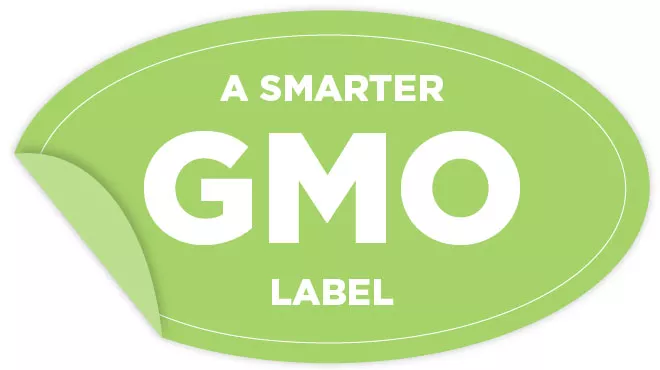Monday, December 2, 2013
How to write a GMO labeling law that's smarter than I-522
The vote on Washington’s Initiative 522 may be over, but the battle over labeling genetically engineered foods isn’t finished. We recently wrote about where the fight in Washington goes from here, and there’s a good chance we may see it on the ballot again.
Some people think any step toward labeling is positive, and others would never support labeling of genetically modified food. (We summarized some different positions here.) But the worst case scenario would be passing a labeling law that has at least some cost and then discovering it doesn’t really tell us anything at all. So here are a few ways to write a smarter labeling law that could probably get broader support.
1. Put the label with the rest of the ingredients information.
Washington’s initiative had the requirement that the GMO label be put prominently on the front of the package, which makes it seem more like a scarlet letter than useful information. (Even California’s very similar Prop. 37 only required front labels for “raw agricultural products,” such as whole sweet corn.)
Because I’m a skeptical consumer and a vegetarian, I’m used to going straight for the nutrition facts and ingredients every time I pick up a product at the grocery store. I imagine a lot of the people who believe in the “right to know” are the same way. So a label on the front of the package is not helpful, it’s inconvenient. Most countries that require GMO labeling include it as part of the ingredients, and that’s the way to go. Proponents say the label isn’t a “scare tactic,” it’s about more information — if that’s true, it would be much better to put it where those of us who care are already looking.
2. Ditch the emotional manipulation and shaky science.
Throughout the election season, the Yes on 522 campaign was very careful not to outright say that you should be afraid of genetically modified food. That’s mostly likely because the scientific consensus is that GMO food is not harmful to human health. But plenty of people have their doubts, which why there’s a push for labeling in the first place, and the Yes campaign didn’t do much to disguise how their organizers and donors really felt. (Some amount of theatrics is to be expected in politics — but delivering the signatures to the statehouse in an ambulance, really?)
More troubling, though, is the connection between labeling supporters and other fringe groups. Dr. Mercola, one of the top donors, is a natural medicine guru who preaches against vaccines and fluoridation while peddling products that consistently get him in trouble with the FDA for making unfounded health claims. (For comparison, the Dr. Bronner’s reason for supporting I-522 is much more reasonable.) The cost study the campaign featured most prominently was commissioned by the Alliance for Natural Health, which counts “vaccine choice” among its top causes and fights regulation of dietary supplements.
Most of labeling campaigns’ top donors are organic companies that would benefit if consumers are scared away from non-organic brands, which makes sense. But the GMO labeling movement often gets dismissed by critics as “anti-science,” and labeling supporters need to take a hard look at the ties to groups promoting unfounded (and dangerous) health claims and denounce them as needed, otherwise there’s a large segment of moderate and conservative voters who aren’t ever going to take it seriously.
3. Require a more reasonable threshold.
The way I-522 was written, it allowed that processed foods could have a very tiny amount of genetically modified material — 0.9% of the total, by weight — without being labeled. Until 2019. Then the threshold expires and presumably drops to zero.
Whenever we talk about keeping something out of the food supply, we’re really talking about thresholds. The FDA has a whole publication called the Food Defect Action Levels that lists how much “insect filth” is allowed in peanut butter, or how many rodent hairs are allowed in spices. These thresholds are very, very low. Another comparison is the new FDA standard for “gluten-free,” which sets the threshold at 20 parts per million.
The “zero threshold” was a talking point for the No on 522 campaign, but it’s valid. The European Union labeling laws allow for the 0.9% threshold, as does the Non-GMO Project. The reason: Keeping agricultural products entirely separate during production, transportation and processing is very difficult and very costly. There’s no realistic way to achieve a zero threshold without entirely removing GMO commodities from the food supply — again, something labeling supporters may want, but that’s a goal that goes far beyond the issue of consumer choice.
4. Make it national.
Labeling supporters frame the issue as the “right to know,” and they’re using the same state-by-state strategy that’s worked in the past for civil rights issues. But regardless of the phrasing, GMO labeling is ultimately more about commerce than rights — and that requires a consistent, national approach.
Many of the large food manufacturers that fight labeling laws sell food worldwide, including countries in Asia and Europe that require labeling. So it’s not like they’re incapable of dealing with this. But the influx of cash in Washington state is just further evidence that they’re not going to acquiesce at the state level. A patchwork of laws that vary a bit from state to state is an organizational nightmare — and local producers are right to worry that it would put them at a disadvantage. (There’s a reason the states that have actually passed GMO labeling laws this year wrote them in such a way that they don’t go into effect until other states get on board.)
Monsanto and the Grocery Manufacturers Association — top donors against labeling efforts — have made public statements about being open to a national law that’s in line with other FDA regulations. And while that may not be entirely genuine, a national law has a much better chance of gaining support from the business community.
5. Consider a label that would tell you more.
A blanket GMO label treats genetically modified food like a simple, black-and-white issue. Either it’s a GMO, or it’s not. If you consider all genetically modified food bad, then this makes sense. But if you actually want to know more about your food, these blanket labels are frustratingly unhelpful.
Which ingredient is genetically modified? What proportion? Is it an ingredient from one of Monsanto’s crops designed to resist pesticides? Or modified for other reasons? What trait was it genetically modified for? Does the part of the plant that was modified actually carry over to the food product?
The momentum is with the GMO issue, but there are many other aspects of food production that seem just as important to know if you’re curious about the content and production of your food: What pesticides were used? Where was it grown? How were ingredients stored and treated? (A new law that just went into effect requires meat to be labeled with the countries where the animal was raised and slaughtered, though it's not yet clear whether shoppers will care.)
At minimum, a useful label should identify which ingredients are genetically modified so consumers can do further research on their own. Otherwise the whole thing is a fight for the right to know very little.
Tags: GMOs , GMO labeling , I-522 , News , Image
















